
* Although the Russian aerospace industry fell on hard times after the collapse of the Soviet Union in the early 1990s, the Su-27 has proven to be a promising success story for the Sukhoi organization. New variants of the Flanker are being developed and the type promises to stay in service for decades into the 21st century.
* There was work on improved versions of the Su-27 from the early 1980s, starting with the single-seat "Su-27M", designed by a team under Nikolai Nikitin of the Sukhoi OKB. The idea was to build a single-seat multirole fighter that could excel as an interceptor, an air-superiority fighter, and a strike aircraft, to complement or replace the first-generation Su-27S in Russian Air Force service.
The Su-27M ended being the basis for a confusing series of demonstrators with refinements and new technology, adding features such as:
These demonstrators were apparently generated by one branch of the Sukhoi organization, it seems the Sukhoi Komsolmosk-on-Amur factory, and were flown up to year 2000. They had a bewildering list of designations, such as "Su-27M", "Su-35", and "Su-37"; the designations "Su-35" can be used to represent the lot.
In the meantime, there was interest in extending the range of the Flanker, partly in support of the PVO air-defense force. That led to a separate line of demonstrators, beginning with Su-27s modified with a retractable inflight refueling probe, similar to that fitted on the Su-27K. The probe was offset to the left side of the nose, and to accommodate it, the IRST was offset to the right.
One single-seat and one two-seat demonstrator were built, being designated "Su-27PD" and "Su-27PU" respectively. The two-seat demonstrator, was seen as more promising, being suited to long-range missions that required two crewmen. Two improved Su-27PU demonstrators were built with:
The first of the two demonstrators flew at the end of 1989, and possibly some others were built. There was little customer interest in the "Su-30", the tentative label for a potential production machine.
The proliferation of demonstrators and corresponding designations for a next-generation Su-27 weren't taken too seriously at the time. One Western observer commented on the Sukhoi OKB in 1995: "They produced more new designations than airframes this year." Given the difficult economic and political environment of the new Russia, it isn't surprising that the development effort had difficulties gaining traction. However, Sukhoi Director General Mikhail Simonov -- who succeeded Pavel Sukhoi after his death in 1975 -- did not, could not give up, and the organization would demonstrate a surprising ability to rise in the face of adversity.
Following the original Su-30 demonstrators, an "Su-30M" two-seat multi-role variant was proposed for Russian use. It went nowhere, Russia having no money for it, but the Sukhoi organization proposed a two-seat export variant, the "Su-30MK", where "MK" stood for "Modernizirovannyi Kommercheskiy / Modernized Commercial".
India expressed interest in the Su-30MK. An Su-27UB trainer dressed up as a demonstrator for the Su-30MK was displayed at the Paris Air Salon in 1993. It featured twelve stores attachments, including wingtip AAM launch rails, three pylons under each wing, a pylon under each engine nacelle, and two pylons in tandem in the "tunnel" between the engines. It was advertised as being able to carry 8 tonnes (8.8 tons) of external stores. Along with conventional dumb high-explosive and fuel-air explosive bombs, cluster munitions, and unguided rocket pods, other stores could include:
Typical warloads would be four Kh-29, Kh-31, or KAB-500 class munitions; or a single KAB-1500 class munition. Of course, it could also carry AAMs, including the R-27 / AA-10 Alamo-A and "dogfighting" R-73 / AA-11 Archer. The demonstrator couldn't haul a heavy warload and only carried dummy stores; production machines were to feature a reinforced airframe to handle the higher take-off weights with a heavy load of stores. A much more optimized Su-30MK demonstrator, rebuilt from a Su-27PU demonstrator, was displayed in 1994, sporting a snazzy desert camouflage paint scheme.
To a degree, the Su-30MK was the Russian answer to the US F-15E Strike Eagle, an air-superiority fighter modified to perform the strike role, capable of multi-role operations. The multi-role capability implied a two-seater, with the pilot handling the aircraft while the back-seater did the targeting, which is why work on next-generation Su-27s focused on the two-seater configuration. Some Western observers shrugged the Su-30MK off as an attempt to sell "old wine in new bottles" -- but Indian pilots who flew and evaluated the demonstrators were impressed, and had ideas for what might be done to improve them.
* In 1996 the Indian Air Force (IAF) ordered 40 "Su-30MKI" fighters at a cost of $1.8 billion USD. The Su-30MKI was to be very much enhanced relative to the Su-30MK demonstrators, featuring further updated avionics, including a much improved radar and a high proportion of non-Russian kit; canard fins; and vectored-thrust engines. The Su-30MKI would definitely be "new wine in new bottles", amounting to a true next-generation Su-27. The deal also included the latest Russian missiles for the new fighters.
The sales agreement was complicated in form and implementation. The full-specification Su-30MKI did not even exist at the time the deal was cut, and so the 40 aircraft were delivered in what amounted to "blocks" of increasing capability, with early aircraft to be upgraded to full specification later. The initial block was punctually delivered in 1997 and consisted of eight "Su-30K" machines, which were basically similar to the Russian Su-27PU -- no relation to the navalized Russian Navy Su-27K carrier fighter. The Su-30Ks were brought to India by Antonov An-124 jumbo jet cargolifters, with each flight carrying two Su-30Ks in knocked-down form. The IAF accepted the first Su-30K into formal service on 11 July 1997.
While these deliveries were in progress, the Sukhoi organization was putting together the first Su-30MKI prototype, a conversion of an Su-27PU, with this aircraft performing its first flight on 1 July 1997. It was essentially an airframe demonstrator, derived from the Su-27UB, featuring:
The original Su-27 was agile for its size, but these improvements took the agility to a new level. Test pilot Vyacheslav Averyanov flew the prototype at an airshow in Bangalore in December 1998, wowing the crowd with its thrust-vectored maneuverability -- but the demonstrator was lost in an accident in June 1999 in an appearance at the Paris Air Salon. Averyanov got a little confused in his maneuvers and bounced the aircraft off the turf. It went back into the sky, but not for long; Averyanov and his back-seater, Vladimir Shendrick, ejected safely before the aircraft fell back down and was destroyed, fortunately with no harm to people on the ground.
A second Su-30MKI prototype, another conversion of an Su-27PU, had performed its first flight on 23 March 1998, and the loss of the first prototype did not delay the program. Averyanov performed a magnificent display in the machine at the Moscow MAKS airshow in August 1999.
Delays were accumulating on the Indian side, however, since the IAF was slow to determine the exact configuration of the avionics suite for the Su-30MKI. The avionics specification was finalized in March 1998, with the primary elements including:
The rest of the avionics was Russian, and overall integration of the avionics suite was to be performed by a Russian subcontractor, RPKB Ramenskoye. The mission systems integrated the sensors to act in a coordinated fashion. The airframe featured reinforcement to handle higher take-off weights.
There was also a change in the delivery plan. Instead of moving through successively improved blocks of machines, the IAF wanted to go straight from deliveries of the Su-30K configuration to deliveries of the full Su-30MKI configuration. Since the full configuration wasn't ready at that time, in the fall of 1998 India ordered another ten Su-30Ks, similar or identical to the original batch of eight, with the new batch delivered in 1999. That meant India acquired 18 Su-30Ks as a stepping stone to obtaining 32 Su-30MKIs.
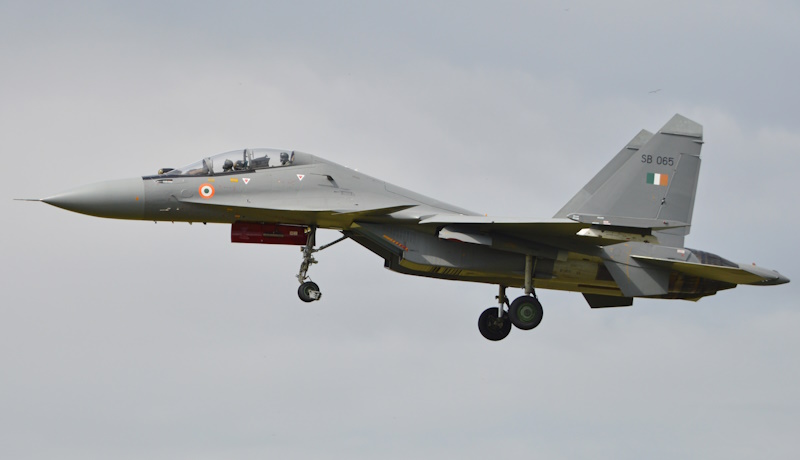
The first preproduction Su-30MKI performed its initial flight on 26 November 2000, with three more pre-production machines completed in 2001, with all four used in test, trials, and evaluation. A fifth pre-production machine was built but only used for ground tests. The first full production Su-30MKI performed its initial flight in late 2001, and the first batch of ten was delivered by An-124 in the summer of 2002, the rest following over the next few years. It wasn't entirely clear from reports what happened to the Su-30Ks for some time; as it turned out, instead of being upgraded to Su-30MKI spec, they were returned to Russia in 2007, to be refurbished and sold to Angola in 2013.
On 28 December 2000, well before the delivery of the first Su-30MKI to India, the Russians signed an agreement with India giving Hindustan Aircraft (now Aerospace) LTD (HAL) the right to license-build Su-30MKIs. Initial production was from kits provided by the Russians, but HAL eventually handled complete fabrication of the aircraft. 222 Su-30MKIs were built to completion of the deal in 2021; at least a dozen more are likely to be made as attrition replacements. The Su-30MKI gave India a formidable air combat capability, based on first-class combat aircraft that combined excellent performance with tactical flexibility and, with inflight refueling, long range.
The original license deal, which also included 200 T-90 main battle tanks, was worth $3.3 billion USD, and was the biggest single arms agreement ever signed between Russia and India. In 2010, when India had about 100 Su-30MKIs in service, a contract was awarded to Sukhoi to update the oldest machines to a more modern spec, with the latest radar and support for advanced weapons like the Indo-Russian BrahMos supersonic cruise missile.
A next-generation update program, featuring the latest avionics and weapons, is being considered for the entire fleet. The "Super 30" upgrade, as it is informally known, will feature an active-array radar, new countermeasures systems, improved engines, and tweaks to reduce radar cross-section -- or at least it will if it ever happens, since at last notice it was stalled. Worse for India, the precipitous decline of Russia since the Russian invasion of Ukraine in early 2022 has made getting spares for India's Su-230MKI fleet more difficult, with a good portion of it grounded.
BACK_TO_TOP* There have been other export successes for the modernized Su-27s. China obtained a batch of ten "Su-30MKK" machines in 2000, with follow-up purchases, as discussed later. These machines were not all that similar to the Indian Su-30MKI, amounting to something of a separate and more conservative branch from the original Su-30MK demonstrators.
The Su-30MKK was a two-seater multirole aircraft with inflight refueling, twelve stores attachments, and the capability of carrying the latest Russian AAMs and smart weapons, but it did not have the "whizzy" canards or vectored-thrust engines of the IAF Su-30MKI. The avionics suite of the Su-30MKK was similar to that of the Su-30MKI, but with some changes -- such as Russian-made Pastel RWR, replacing the Indian-made Tarang RWR; the N001VE radar, an improved variant of the Mech-series multimode radar.
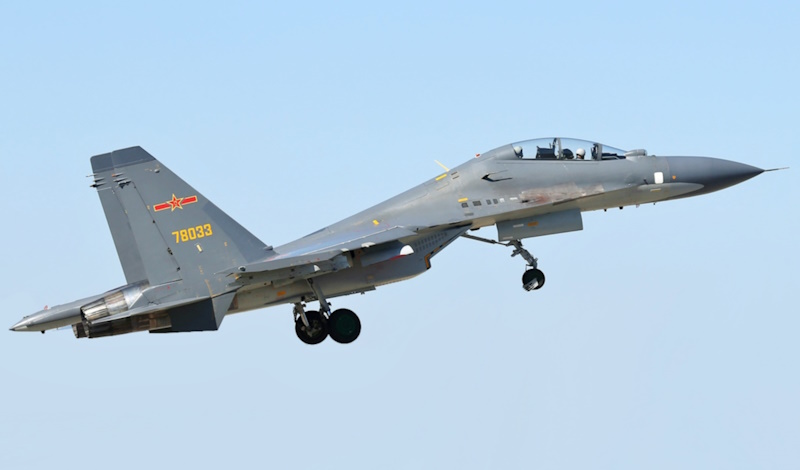
Incidentally, one of the few distinctive recognition features of the Su-30MKK was that it had the tall flat-top tailfins evaluated on some of the Su-35 demonstrators, with antennas for the Pastel set mounted near the top rear of the tailfins. The Su-30MKK also had slightly increased internal fuel tankage, as well as stronger landing gear and airframe reinforcement to handle increased take-off weight.
Following the flight in March 1999 of a modified Su-27PU demonstrator to evaluate the new avionics suite, the first production Su-30MKK performed its initial flight on 19 May 1999, with Averyanov at the controls. Deliveries of the first batch of ten to China were in 2000:2001. Other foreign sales followed:
The Russian Air Force -- rendered from 2015 as "Russian Aerospace Forces (Vozdushno-Komicheskiye Sily / VKS) -- was slow to become interested in next-generation two-seaters, presumably because of funding issues. Since 2012 the VKS, and Russian Naval Aviation (Morskaya Aviatsiya Voyenno-Morskogo Flota / MA-VNF), have obtained over 116 Su-30SMs, from initial deliveries in 2013. They were similar to the Su-30MK2, the distinctions being additional radar modes, plus Russian-made avionics such as IFF and datalink, with more Russian-made kit being incorporated over time. They did have the canards. From 2022, deliveries were of "Su-30SM2" machines, featuring modernized avionics.
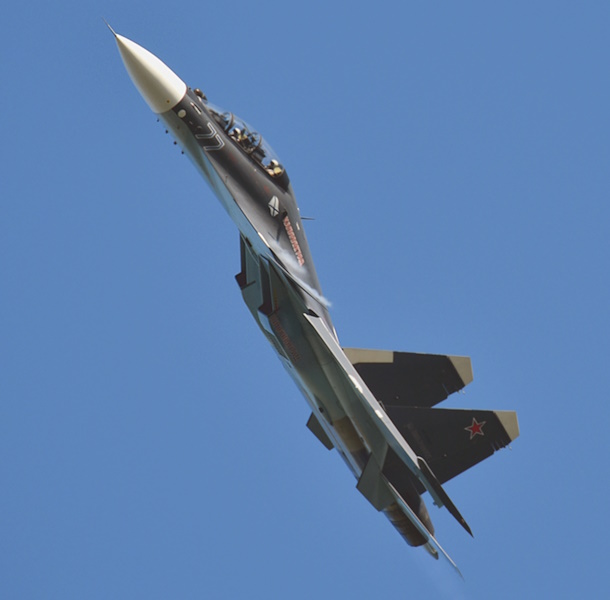
The Russian Knights re-equipped with the Su-30SM. Su-30SMs flew top cover for strike packages during the Russian intervention in Syria in 2015:2016, and apparently also performed strikes themselves. The Sukhoi organization has promoted an "Su-30SME" for the export market, which will feature largely Russian-made kit. From 2012, the Russian Ministry of Defense also ordered 20 "Su-30M2" two-seaters for operational training. Details are scarce, but they appear to be Su-27UB trainers with modernized avionics.
BACK_TO_TOP* As it turned out, the Su-30MKI was built by Sukoi factory in Irkutsk, while the Komsolmosk factory was building the Su-30MKK/MK2 for China. Komsolmosk factory leadership started to feel that they were trailing the Irkutsk factory and wanted to catch up. In 2003, the Russian government began to push the "PAK-FA" program, which would ultimately result in the Sukhoi Su-57. Komsolmosk leadership decided to leverage off the new technology being developed for the PAK-FA to generate an improved Su-35 variant, featuring:
All avionics was of Russian origin to defy increasingly tough Western sanctions. A Ukrainian-made HMS was originally used, but replaced by a Russian-made HMS. Two prototypes were flown, using organization funds, initial flight of the first being on 19 February 2008, the second the next year. Initial flight of the first production-standard "Su-35S" was on 3 May 2011. A two-seat "Su-35UB" was introduced as well.
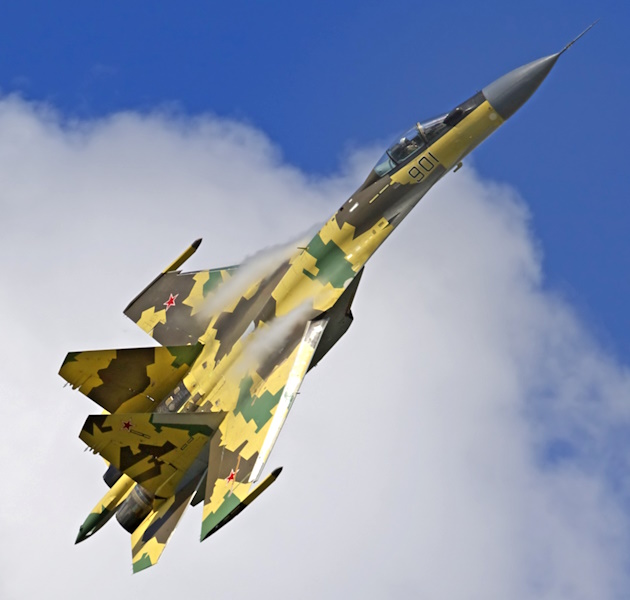
The Russian MOD ordered 48 Su-35s in 2009, and 50 more in 2015. The Chinese ordered 24 Su-35s in 2015, discussed in more detail later. Indonesia ordered 11 Su-35s in 2018, while Egypt ordered 20 in 2019 100 had been delivered by the end of 2020.
* The Su-35 line did pave the way for an upgrade program for Russian Su-27s. About 700 Su-27s of all types had been built up to the time of the collapse of the Soviet Union. The dust took some time to settle, the process including the dissolution of the PVO and its absorption into the VVS in 1998.
The Su-27 remains the first-line fighter of the VKS, serving in roughly a dozen air regiments. The Su-27 promises to remain good for many more years of effective service, particularly because financial constraints have cut their flight hours, extending their airframe lives. However, to remain effective weapons they had to be upgraded. The Flanker upgrade program remained murky for some time, with the VKS considering at least seven different upgrade paths and the Sukhoi organization flying a confusing set of "Su-30KN" test configurations. Initial concepts proved too ambitious, and it wasn't until 2002 that a consensus began to emerge on a multirole "Su-27SM" upgrade, driven by technology from the Su-30MK2 two-seaters sold to China.
The prototype Su-27SM, upgraded from a late-production Su-27S, performed its initial flight on 27 December 2002, with Yegeniy Frolov at the controls, and made its public debut at the MAKS airshow in Moscow in August 2003. The full-specification Su-27SM upgrade featured:
A mid-air refueling probe was not part of the upgrade, since the VKS didn't specify that as part of the requirement. The first 24 Su-27SM upgrades were complete by late 2006, with 24 more following by 2009. Some have been upgraded with improved AL-31F engines. A dozen new-build machines, designated "Su-27SM3" -- with updated avionics and compatibility with new weapons -- were ordered in 2011, assemblies for these aircraft having been fabricated for a Chinese order that didn't pan out. They featured further updates, including more powerful "AL-31FM1" engines; a refined glass cockpit; 12 stores pylons; an updated Pastel defensive jammer; and a modestly improved N001VP radar, mostly to support improved AAM armament.
It doesn't appear any more Su-27SM3 upgrades have been performed, with much of the VKS fleet still consisting of baseline Su-27S machines. Obviously, the VKS would like to upgrade to new machines, but almost as obviously the money isn't there.
Flanker-family machines participated in the invasion of Ukraine in early 2022, but not to much effect. Much to everyone's surprise, Russia did not quickly obtain air dominance over Ukraine, and never got it later. Partly that was due to the half-baked way the invasion was planned, intelligence suggesting the Russians thought it would be a simple walk-over, with little resistance. Coordination between Russian ground forces and the VKS was somewhere in the range of "poor" to "nonexistent", and Russian air strikes on Ukrainian aircraft were rendered generally ineffectual by dispersal and enthusiastic use of decoys.
In reality, Ukrainian resistance was ferocious. As the war settled in, surface-to-air missile defenses on both sides proved so formidable that neither side attempted to overfly the other, with aircraft that did cross the battle line usually being quickly shot down. The Russians fell back on stand-off weapons, particularly cruise missiles, launched from bombers. Later in the war, the Ukrainians acquired long-range drones and cruise missiles and began to pick off Russian air assets on the runways at their home bases.
The Flanker, in short, played no serious role in the war -- the Ukrainians, on their part, making more use of Su-24s, Su-25s, and in particular MiG-29s, often adapted to carry modern Western-style munitions. The war suggested that the Flanker, in all its guises, was obsolescent. Another surprise for the Russians following the invasion was the imposition of harsh sanctions by Western nations, with the Russian economy slowly running down. Export sales of Russian weapons had been in decline over the past decade. With the Russian state facing economic, political, and social collapse, it was hard to know if its aircraft industry had a future.
BACK_TO_TOP* One of the most unusual Su-27 derivatives was the "Su-34", a dedicated strike variant with a completely redesigned front fuselage that provided side-by-side seating. Development of the "T-10V-1", as the Sukhoi OKB originally designated it, began in the early 1980s. The first prototype flew on 13 April 1990, with the designation of "Su-27IB", but the aircraft was kept a secret for several years.
The end result of the secrecy was a bit of confusion over the type. Mikhail Simonov originally claimed it was an "operational trainer for carrier landing", with this story reinforced by a picture of the Su-27IB coming in for a landing on the KUZNETZOV -- though sharp-eyed observers noted that the aircraft did not have an arresting hook extended, and was likely only making a "touch-&-go" for the cameraman.
When details finally became available, the story about the carrier trainer evaporated -- though as discussed later, it doesn't appear that Simonov was actually lying. The Su-27IB was instead revealed to be a strike aircraft, with the "IB" standing for "Istrebitel Bomardirvoschik / Fighter Bomber". It was intended to replace the Su-24M "Fencer". Sukhoi OKB officials referred to the type originally as the "Su-32", with the organization still using that designation, though it is more generally known as the "Su-34" -- and that is the designation used here. VKS brass originally stuck to the Su-27IB designation, but eventually came around to the Su-34 designation since it was, after all, visibly a different aircraft from the classic Su-27. NATO assigned it the relatively flattering name of "Fullback", which defines an offensive player position in American football.
The initial prototype was an SU-27UB mated with the new forward fuselage for aerodynamic validation, with a full-specification "T-10V-2" prototype flying in 1993. Five more flight prototypes, plus two static-test prototypes, were built as well. Su-27 wings, tail, and engines are retrained, though canards have been added. The Su-34 has fixed-geometry engine inlets, meaning it is not capable of high supersonic speeds, but that was apparently not regarded as important for the strike role. A retractable inflight refueling probe was added, while the dorsal airbrake was deleted.
The aircrew flew the aircraft using a modern glass cockpit, with wide-angle HUD and color flat-panel cockpit displays. The seats had a massage function to reduce crew discomfort and fatigue on long flights. The side-by-side cockpit was said to be roomy and comfortable, giving enough headroom to allow a crewperson to stand up. It even had a toilet and a galley -- though it was also said that its cockpit visibility is unsurprisingly inferior to that of fighter Su-27 variants. The cockpit was protected from ground fire by a titanium "bathtub", and titanium armor was also used to protect fuel tanks. Entry to the cockpit was through a ladder in the nosegear well.
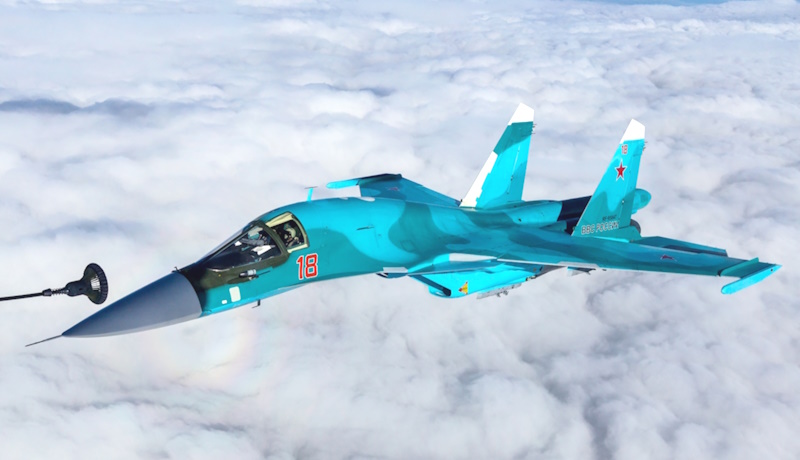
The total weight of added armor was estimated at about 1.5 tonnes (1.65 tons). The Su-34 had the twelve stores attachments of the Su-30MK series, and a total warload capacity of up to 8,000 kilograms (17,635 pounds) -- including unguided bombs and rockets, plus the latest Russian smart air-to-ground munitions. The GSh-301 cannon was retained, while the Su-34 could carry short-range and long-range AAMs, allowing it to take care of itself if attacked by adversary fighters.
The maximum take-off weight grew by 50% compared to the Su-27UB. The airframe was reinforced and the undercarriage was fully updated, with the main gear having tandem wheels on longer struts, and a two-wheel nosegear that retracts backwards. Other features included:
The Su-34 had an operational radius 50% greater than that of the Su-24 it is to replace, as well as much more modern avionics and weapons. The appearance of the Su-34 was clearly different from that of any other Su-27 variant, even to the untrained eye. Some found its appearance exotic and science-fictional, others found it grotesque -- but all agreed that it was out of the box.
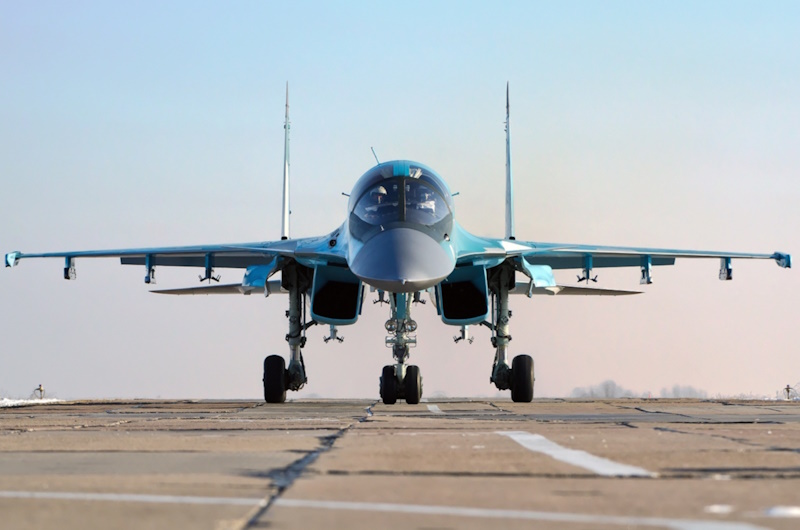
The Su-34 was slow to enter service. The program remained generally stalled through the late 1990s, when it was originally supposed to go into service. By the beginning of 2003, only two prototypes and four pre-production machines had been completed.
The Russian Air Force ordered a batch of 32 production machines in 2008; by the time first deliveries took place, the program had dragged on so long that the design had to be upgraded with a more satisfactory radar system before putting it into production. The first aircraft did not reach formal service until late 2011. Final deliveries of that batch were in late 2013; a second batch of 92 was ordered in 2012, with deliveries to 2020. The Su-34 performed strikes in the Syrian intervention in 2015.
The Sukhoi organization has worked on the "Su-34R" reconnaissance platform, with "R" standing for "Razvedchik / reconnaissance". Although the Su-34R was originally to have been an optimized reconnaissance machine, the decision was made to keep it similar to the bomber version, providing the reconnaissance system, designated BKR-3, as a set of external pods -- including the M402 Pika-M side-looking radar; the UKR-OE opto-electronic imaging pod, with daylight camera and infrared line scanner; and the UKR-RT SIGINT pod. Photos of trials aircraft were released in 2015.
There has also been consideration of the "Su-34PP" countermeasures aircraft, with "PP" standing for "Postanovshchik Pomekh (jammer platform)". Again, though a substantially modified airframe was originally considered, the decision was made to simply boost the Khibiny-V jammer system, backing it up with L700 Tarantula pods. In addition, the Sukhoi organization promoted an "Su-32FN" maritime strike version for the export market, but nobody was interested.
At least 148 production Su-34s, plus 7 trials machines, have been built, with late production in updated "Su-34M" configuration, and talk of upgrading older machines. The Su-34 was never exported. Su-34s saw combat during the Russian intervention in Syria from 2015, and in the invasion of Ukraine from early 2022. At least 20 were lost during the Ukraine operation, both from accidents and from Ukrainian air defenses.
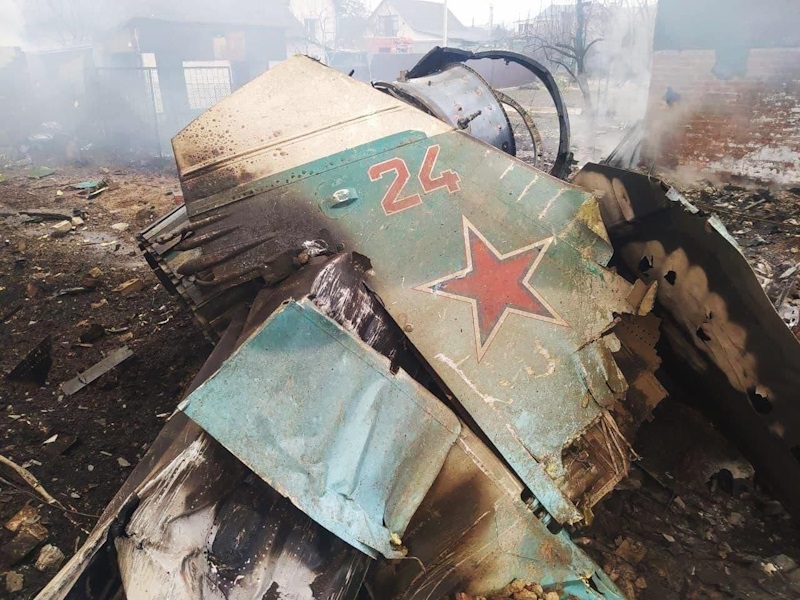
* As far as the tale about the carrier-based trainer went, the Sukhoi organization had considered a two-seat Su-27 trainer with side-by-side seating, beginning work on the "T-10KM2" in the late 1980s. This variant actually emerged a decade later as a prototype for the "Su-27KUB" two seat trainer, which is essentially an Su-27K / Su-33 carrier-based fighter -- with folding wings, arresting hook, and so on -- mated to a side-by-side cockpit. The initial prototype was a conversion of an Su-27K / Su-33 and performed its first flight on 29 April 1999, with Pugachev and Sergey Melnikov at the controls. It went on to perform trials on a ground-based ski-jump beginning in September. The prototype featured slightly enlarged wings and tail surfaces.
A side-by-side cockpit arrangement was regarded as more effective for carrier operations training, since it gives the instructor a better view than he would have as a back-seater -- an important consideration for "hairy" carrier landings. As the initial Su-27IB / Su-34 prototype was basically a modified Su-27UB with a side-by-side cockpit with few other optimizations, in a sense it could be regarded as having been a demonstrator for the Su-27KUB as well, and Simonov was probably just sounding out interest in the concept, or at the very least trying to keep the T-10KM2 effort alive.
In side profile, the Su-27KUB looked deceptively like a single-seater Su-27, since it retained the standard large radome and the IRST in front of the canopy -- through in top aspect, it more resembled the Su-34 with the side-by-side cockpit. There was talk of taking it into production, it being seen as not only useful for training, but in strike, reconnaissance, countermeasures, and tanker roles as well. It was considered as a possible airborne early warning aircraft, carrying an electronically steered radar antenna in a spine canoe fairing. A second prototype was built, but that was as far as it got.
BACK_TO_TOP* As mentioned in the previous chapter, the Chinese were the first foreign buyers for the Su-27, ordering 20 Su-27SK and 6 Su-27UBK machines in 1991, with deliveries from 1992. The Chinese had been trying to obtain advanced combat aircraft technology from the West, but that avenue was closed by sanctions after the Tianemen Square massacre in 1989.
The Chinese followed that up with a 1995 order for 16 Su-27SKs and 8 Su-27UBKs, with deliveries from 1996. In that year, the Chinese signed a license agreement to allow them to produce up to 200 Su-27SKs on their own, using knockdown kits provided by Sukhoi, these machines being designated "Jian-11 (J-11)", the first such machines flying in late 1998. To provide training support for the new single-seaters, China ordered 28 more Su-27UBKs in 1999, with deliveries from 2000.
The Chinese went on to obtain the Su-30MKK, with an initial batch of ten machines delivered in a block in late 2000, being ferried to China and greeted with considerable fanfare. The remaining 28 in the order were delivered through 2001. The Chinese were very impressed with the fact that the contract had been fulfilled so well and quickly, and a year later China ordered 38 more Su-30MKKs, which were delivered during 2002 and 2003,
These 76 Su-30MKKs were for the Chinese air force. In January 2003, the Chinese navy ordered 24 more, with an enhanced N001VEP (AKA "RLPK-27VEP") radar and fire-control system for launching the Kh-31A / AS-17 Krypton antiship missile. These machines were given the designation of "Su-30MK2". Deliveries may have begun in 2003, and more may have been ordered. All the Chinese Su-30MK derivatives are candidates for upgrades, such as improved radar or engines, plus carriage of Chinese-made munitions.
* The story of the license-built J-11s is murky. After initial Chinese assembly from kits, the program bogged down, due to Chinese complaints about the obsolescence of the Russian-supplied systems, notably the N001 radar. After negotiations, the Chinese got the N001V and then the N001VE radar, with aircraft also obtaining a glass cockpit. The improved machines, produced from 2000, were designated "J-11A", with older machines upgraded to J-11A standard. The ambiguous element is that some sources claim the Chinese built the J-11As themselves -- that they weren't built from kits or Russian assemblies.
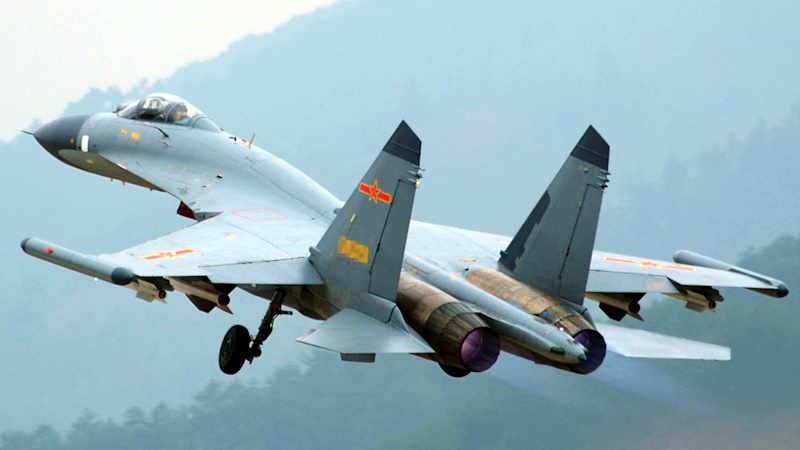
Whatever the case, after obtaining about 105 J-11 / J-11A machines to 2006, the Chinese introduced their own variant, the "J-11B", on their own, with:
It took some time for the Chinese to get the engines and avionics up to operational scratch. There was, not surprisingly, a noisy feud between the Russians and the Chinese over licensing rights. This is apparently why there is an ambiguity over J-11A production, there being competing stories.
The Chinese Navy obtained a similar land-based single-seat variant, the "J-11BH". The Chinese reverse-engineered the two-seaters and built their own, the "J-11BS" (or "J-11BSH" for the Chinese Navy's version), with initial flight in 2007, and introduction to service in 2010. The J-11A/Bs appear to be receiving updates, such as new defensive systems, new cockpit display systems, and other avionics improvements to keep them up-to-date.
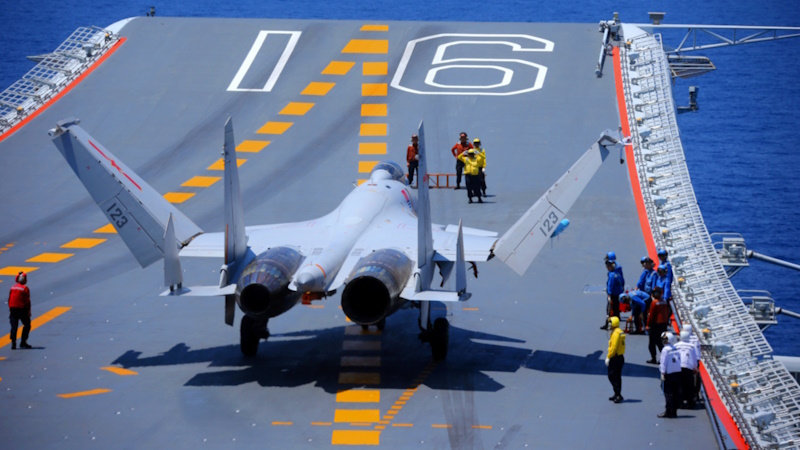
The J-11B has been followed by a "J-15" -- originally "J-11C" -- single-seat multi-role carrier fighter, with first flight of a prototype on 31 August 2009. It featured:
It was not catapult-capable, it seems instead relying on ski-jump decks. A catapult-capable variant followed initial production. A two-seat conversion trainer, the "J-15S", was developed as well, initial flight having been in 2012. The J-15S was seen as the basis for other variants:
Prototypes of a "J-11D" performed initial flights in 2015, being said to have modernized avionics, including an "active array" radar; uprated WS-10IPE engines; an extra stores pylon under each wing; an inflight refueling probe; and more composite assemblies. It is suspected the J-11D is a template for upgrade machines.
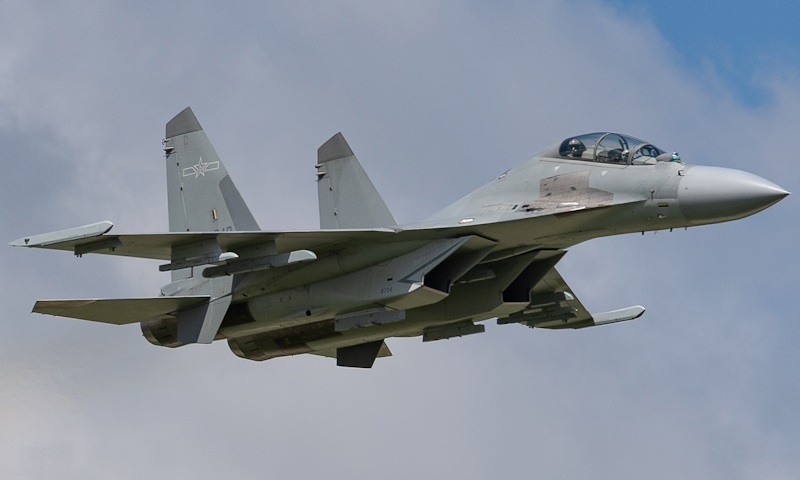
The Chinese have developed a strike-oriented derivative of the Su-30MKK, the "J-16" -- featuring Chinese avionics, including a glass cockpit plus an active-array radar, plus WS-10A engines, and capable of handling most or all Chinese offensive stores, notably antiship missiles. Initial flight was in 2011, with introduction to service in 2015. An electronic warfare (EW) variant, the "J-16D", appeared in late 2015. This machine features a cylindrical pod on each wingtip for EW gear, various more discreet fairings and ports for EW gear, and no cannon. It is apparently a parallel effort with the navalized J-15D.
As mentioned, China ordered 24 Su-35s in 2015, with deliveries in 2016:2018. The Russians were somewhat reluctant to make the deal, knowing how China had lifted Su-27 technology, but Chinese money was good. It was somewhat puzzling as to why China obtained the Su-35 when they were producing increasingly advanced Su-27 derivatives themselves. It is unlikely they saw the Su-35 as a frontline aircraft, instead intending to use it for dissimilar air combat training, familiarization with vectored-thrust engine flying, and no doubt some reverse-engineering.
BACK_TO_TOP* Sources include:
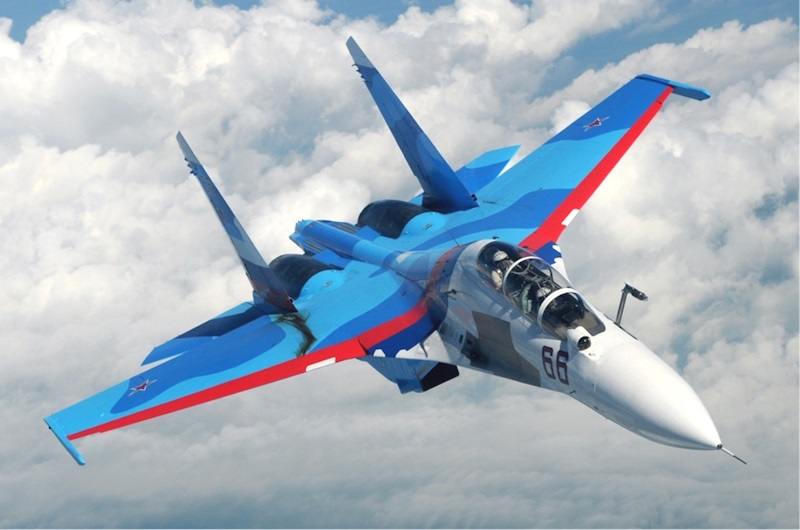
* Illustration credits:
* Revision history:
v1.0 / 01 aug 00 v1.0.1 / 01 feb 02 / Minor corrections. v1.0.2 / 01 jun 02 / Added comments about Sukhoi win of PAK-FA. v1.1.0 / 01 feb 04 / Split into chapters, interim general rewrite. v1.2.0 / 01 mar 04 / Final general rewrite. v1.2.1 / 01 aug 06 / Review & polish. v1.2.2 / 01 jul 09 / Review & polish. v1.2.3 / 01 may 10 / Review & polish. v1.3.0 / 01 apr 12 / Removed Berkut & T-50 for discussion elsewhere. v1.4.0 / 01 mar 14 / Su-30Ks sold to Angola. v1.4.1 / 01 feb 16 / Review & polish. v1.5.0 / 01 jan 18 / Extensive rewrite, updates. v2.0.0 / 01 oct 23 / Updates, new illustrations. (*)BACK_TO_TOP
